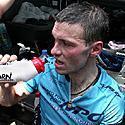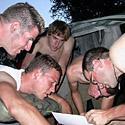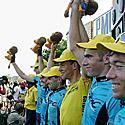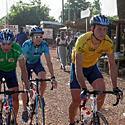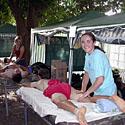
Recently on Cyclingnews.com |
Tales from the travellers — the diary of Team Marco Polo
Marco Polo wins again in Faso
Tour du Faso, Burkina Faso, October 29-November 9, 2003
By Gudo Kramer
This year was the 17th Tour du Faso. That is quite a tradition for cycling in Africa. The country Burkina Faso has some cycling history, even a with a few pro criteriums years ago. In fact, Italian legend Fausto Coppi was infected with malaria in Burkina Faso - a disease from which he died from.
Three years ago, the Societe du Tour de France (now called ASO) got involved and became co-organiser. This year's Tour du Faso was from October 30 until November 9. In the 11 stages over 12 days, it covers 1245 kilometres. Not so much for 11 stages, but with temperatures hitting 40 degrees Celsius, it is more than enough! The roads are the slowest, roughest asphalt you can imagine. This year, there were even some parts on sandy roads again. The event is a celebration in this country: everywhere people come out to watch the race, newspapers are full of cycling and the television shows reports of the race.
The team
The Marco Polo Cycling Club went to Africa with three riders that already had experience in this race. Maarten Tjallingii, a strong mountain-biker from Holland, was one of the strong domestiques that made the victory for Joost Legtenberg in 2001 possible (together with Bram de Waard and Nathan Dahlberg). Lionel Syne rode this tour last year and won the green points and the pink sprint jersey. And I, Remko Kramer, raced three stages last year and spent the rest of the tour sick in bed. Other riders on the team were: German all rounder Kay Kermer, domestique Rutger Kock from Holland and young "rookie" Dave Washburn from the USA.
We also had a unique staff: three girls were taking care of everything around the race. Francis Cerny from Germany, Petra Hofs from the Netherlands and Isabelle Piscart from Belgium did a great job and took care of photos, all logistics, feeding/drinks and massage, kept the team updated in the race and changed flat tyres. Halfway through the Tour, a few of the journalists that follow the Tour du Faso noticed that all the Marco Polo staff were female, so they asked the girls what was the secret to the success of the team. Of course they didn't tell them!
Preparation
Because the race is so late in the year, it is hard to have good preparation. There are no more races and the weather is bad for training in Europe. Preparing for the heat is especially hard. In the weeks before departure, it was already snowing and freezing in Europe. So we trained hard on the rollers with the heater on to get ready. Dave Washburn from the USA even let his hair on his head, legs and his beard grow and trained with leg warmers, long sleeves and gloves in sunny California!
A week before departure, the flight was changed from arriving two days before the race to arriving in the afternoon on the day before the first stage. So we departed in Paris in the early morning where people were scratching ice from their car windshields, and in the afternoon, we arrived in Ouagadougou, where it was 40 degrees Celsius! We had just enough time to have a ride before it got dark.
Stage 1 - October 29: Ouagadougou - Kaya, 111.5 km
The next morning at 8 we started the first stage of the Tour du Faso. From other years we knew how important the first stage could be in a flat stage race like this, so we were trying to cover each break. After about 30 kilometres, we got away with a group of about 15 riders with Maarten Tjallingii and me (Remko Kramer) from Marco Polo in it.
We worked well together with a few guys and got a good three minutes gap from the field. Then with still 70km to go, some riders started arguing with others who just sat on. That was the end of the cooperation and the start of attacks. We covered each attack and the temperature was rising above 40 degrees. I thought my head was about to explode and I asked myself what made me decide to race here again. But Maarten got away in a group of four and he looked really strong!
I had some bad luck with a flat tyre three kilometres before the finish but Maarten took care of things and won the stage and took the first yellow jersey! Everybody was overheated, dehydrated and just dead after the finish. Maarten looked still good, however he said he didn't feel really strong yet.
Stage 2 - October 30: Kaya - Ziniaré, 70 km
Defending the yellow jersey
Because we didn't have the "power-team" to control the race from the front and because we still had 10 stages before us, we decided to defend the jersey by covering the breaks and make sure we would have a rider in the break so we don't need to chase and Maarten should concentrate on his opponents in the same time on GC as him.
This tactic worked out well on Stage 2, with a break going with Kock Rutger as well as Kay Kermer in it. But with such small time differences, we almost lost the jersey towards the end. We had to ride in the peloton in the last kilometres to gain some precious seconds. At the same time, Rutger almost won the stage with a nice move in the last kilometre, but with a strong Burkinese on his wheel he decided not to pull through, then Kay came through with a strong sprint and won the stage!
Stage 3 - October 31: Kokologo - Boromo, 132.5 km
The yellow jersey attacks!
In the third stage, Maarten Tjallingii did something I never heard of before. It was a flat stage and at halfway mark, he got away with five riders - all strong riders with good chances on GC. The best-classified African, Gweswende Sawadogo (Sifa - Peugeot), who could make some good time in this group, didn't want to ride. Maarten argued with him and was so angry with him not riding, that he decided to attack the group. He got away by himself, but still had 70km to go!
In the main field, a French team organised and took back the rest of the group before they noticed that one rider was missing. The yellow jersey was still up the road, 1'30 ahead! Another team took over the chase, but 10km later, the difference had grown to 1'45. We got worried... what was Maarten doing? But the girls in the car went to him and he said he was riding at reserve still. Only Belgium ex-pro Gunther Cuylits could get over to him with 15km to go and beat him at the finish. But Maarten gained some time again on the rest of the field. What a ride!
Lack of experience
The African riders are physically strong cyclists, but they don't have many races and therefore miss a lot of experience. A good example of the lack of experience of the African riders was a sprint between Kay Kermer and Burkinese rider Abdoulaye Ouedraogo (A.S.Fadoul) on Stage 10 finishing in Fada N'Gourma. Ouedraogo passed Kay, but forgot to throw his bicycle in front of him. Kay swung behind his saddle and won the stage by four hundredths of a second, despite being behind the African at the line.
The African riders miss the experience we have from racing each weekend during the season. We get along well with them and have made some good friendships during the tour. We also try to give them some advice for their training and racing. We really hope they will have some more races during the year so they can improve their skills and tactics.
On Stage 5 finishing in Bobo Dioulasso, the Burkinese showed some really good teamwork. They missed a break and organised a chase. They brought back a three minute gap in 30 kilometres, but for the last 30 seconds, they went as hard as they could and only their strongest riders could take turns. When the next attacks came, they were too tired to get in the next break.
Tent camp
In the capital of Ouagadougou and in Bobo Dioulasso we stayed in hotels, but the rest of the tour we had "bivouac". This was a complete camp, with a mobile kitchen and showers and toilets in tents. The meals were served at big tables in the open air. We slept in big tents with mattresses on the ground, the nine of us (six riders and our three staff) in one line, with mosquito nets hanging from the roof of the tent.
Staying like this with all teams in tents makes for a good atmosphere. The teams meet each other and talk about the race and cycling in general. The Africans are friendly and the Europeans are adventurous, open people. This gives a good atmosphere and everybody gets along well.
Getting sick
Apart from the heat, there is the danger of getting sick. Many riders get sick during the Tour du Faso. It is hard to stay healthy because of the exercise in the extreme heat, the daily dehydration and the body's lower resistance from exhaustion. And with unknown bacteria in the food, you can get sick easily.
Kock Rutger and Dave Washburn had a hard time. They got sick but still started each day. On Stage 8, they got dropped early in the stage and had to ride against a headwind on the slow, rough asphalt. They struggled and made it to the finish, but one hour after the winner and were taken out of the race.
Also bad luck for our sprinter Lionel Syne, who crashed hard. His shoulder was in a strange position and he thought his collarbone was broken. But in the hospital, his shoulder popped back in, it was (only!) dislocated. Lionel wanted to go back to the place where he crashed to finish the stage. However his bicycle disappeared! It was taken by the police and came back long after the stage.
Green jersey
Kay Kermer - probably the first German in the Tour du Faso - started off with a stage win on Stage 2 along with several podium placings. He also won the green jersey and the final stage and finished third on GC.
Keeping the yellow
Maarten Tjallingii was stronger then anyone expected. He defended the yellow jersey and even attacked a few times. On his birthday on November 5 (Stage 7), he attacked from the front group with 15 kilometres to go, and only Frenchman Jonathan Kern could beat him at the finish. A second place and holding the yellow jersey for another day was also a nice birthday present.
On the last stage (Stage 11) with the finish in Ouagadougou, Maarten showed that he really deserved to win this Tour du Faso. Entering the final laps, he got away with top French mountain-biker Thomas Dietsch (who almost won the first Marathon World Championships) and Brice Bouniot. Maarten finished second on the stage and won the Tour du Faso almost four minutes ahead!
Tour du Faso homepage
See also: A rider's
eye view of the Tour du Faso by Francis Cerny.
For more information on the Marco Polo Cycling Club and its travels, visit: www.marcopolocycling.com

